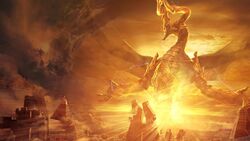Final Hours
- For the prophecy, see Accounting of Hours. For the set featuring the event, see Hour of Devastation.
| Final Hours | |||||
|---|---|---|---|---|---|
| Information | |||||
| Era | Mending Era | ||||
| Date | 4560 AR | ||||
| Location | Naktamun, Amonkhet | ||||
| Sets | Hour of Devastation | ||||
| Affiliations | The Gatewatch | ||||
| Characters | Asenue, Bontu, Chandra Nalaar, Djeru, Gideon Jura, Hapatra, Hazoret, Jace Beleren, Kawit, Kefnet, Liliana Vess, the Locust God, Makare, Nicol Bolas, Nissa Revane, Nylah, Oketra, Razaketh, Rhonas, Samut, the Scarab God, the Scorpion God | ||||
| Result |
| ||||
| Timeline | |||||
| |||||
The Final Hours was an event that took place in the city of Naktamun on the desert world of Amonkhet.
Description
According to the doctrines of the five gods, the return of the God-Pharaoh would mark the fulfillment of his great promise to the people of Naktamun, unfolding in four fateful stages:
The Hour of Revelation — As the Second Sun aligned perfectly between the God-Pharaoh’s monumental horns, the long-awaited gates to the Afterlife would open wide. In this moment, the radiant truth of the God-Pharaoh’s divine plan would be laid bare for all to see.
The Hour of Glory — Those who still lived and had yet to complete the gods’ trials would face one last chance to prove themselves worthy. Even the gods would stand ready to greet the God-Pharaoh’s return, hoping to secure their place at his side beyond death.
The Hour of Promise — With the God-Pharaoh’s power fully restored, the world would be remade into a flawless paradise. The protective Hekma would become unnecessary, as the life-giving waters of the Luxa would once again flood the desert, taming the wastes and the roving undead.
The Hour of Eternity — In this final stage, the loyal and proven people of Naktamun would join the God-Pharaoh forever, granted everlasting existence in a perfect afterlife. Each god held their vision of what this eternal state would be, but all agreed that it would be an unending realm of ideal perfection and renewal.[1]
Alignment of the Second Sun
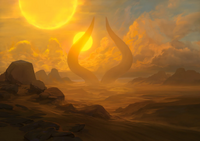
In 4560 AR, after sixty years of steady approach, the Second Sun finally aligned between the horns of the Throne of the God-Pharaoh, just beyond the Gate to the Afterlife. Instead of welcoming the God-Pharaoh's return, this event unleashed the end of the world for Amonkhet. This devastating apocalypse overturned all that the people believed. Everyone expected the God-Pharaoh's return with eager devotion, but none foresaw that it would bring utter ruin and betrayal. In that moment, Nicol Bolas revealed how completely he had deceived his faithful followers and even the gods themselves. The people and gods believed the God-Pharaoh would open the Gate to the Afterlife to welcome the worthy. Instead, the gates opened on their own, unleashing a nightmare. Three unknown gods of destruction emerged, shattered the Hekma, and slew most of the other gods. Mummies swarmed in from the desert while an army of lazotep-plated undead, the Eternals, poured from the necropolis to join the slaughter. In mere hours, the paradise of Naktamun became the nightmare the Gatewatch had feared from the start.[1]
As their world collapsed, the people of Naktamun reacted in different ways. Some saw the horrors as the God-Pharaoh's final test. These zealots hurled themselves against the mummies and Eternals, hoping to prove their worth in battle and force a way into the afterlife by reaching the open gates upriver. Others took the destruction as proof that the God-Pharaoh had failed. His absence, once explained as time spent preparing the afterlife, now seemed an empty promise. Mourning their god, these people fought on for survival, defending themselves with the combat skills they had honed all their lives, hoping to honor his memory with one last stand. A few, mostly those who already doubted, saw the truth behind the betrayal. Their faith broken, they fled into the Shefet desert, believing even its horrors were better than the nightmare Nicol Bolas had wrought inside the city.[1]
The Hour of Revelation
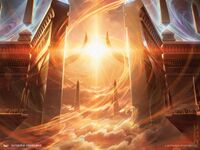
When the Second Sun aligned perfectly between the horns of the God-Pharaoh, the long-sealed Gate to the Afterlife finally opened. Citizens from every corner of Naktamun, along with the gods themselves, gathered in awe to witness the fulfillment of the God-Pharaoh's promise. From within the parted gate poured a terrible surge of power, revealing the Crypt of the Eternals — a vast necropolis lying hidden beyond the Hekma, filled not with paradise but with countless generations of preserved dead. Rather than the blissful afterlife they had been taught to expect, the people found only rows of silent tombs, and the Throne of the God-Pharaoh still sat vacant.
Soon, a deep crimson tide began flowing down the Luxa river from the open gates, turning its waters to blood. At the source of this corruption, near the great tomb within the necropolis, a massive, winged demon appeared and towered above the terrified onlookers. Whispers spread quickly through the crowd — could this vile creature and its foul rite have stopped or postponed the return of the God-Pharaoh? Surely, such corruption could not belong to a servant of their supposed savior.
The Gatewatch arrived at the scene and instantly recognized the demon as Razaketh, sworn enemy of Liliana. Acting in concert as they had against the Eldrazi, the planeswalkers struck the demon down swiftly, sparing Liliana from resorting to the hated power of the Chain Veil. But as Razaketh fell, the massive doors of the tomb behind him swung open ominously.
The Hour of Glory
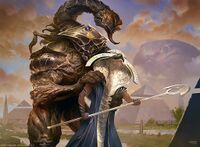
Within the newly opened tomb stood three sarcophagi, and as Razaketh’s corpse lay cooling, the first one cracked open. Out stepped a towering figure — larger even than Naktamun’s divine beings — with the lithe form of a humanoid and the menacing head and tail of an enormous scorpion. The doctrine of the God-Pharaoh had foretold that the Hour of Glory would allow any who had yet to prove their worth — including the gods — to earn their rightful place in the afterlife. Hideous as this Scorpion God seemed, some believed it had come to deliver that promised glorious end. Rhonas, god of strength, stepped forward to confront the monster and win the reward he had so fiercely earned. Yet the Scorpion God's tail struck with lethal force, and Rhonas fell in agony — his death swift but excruciating.
Horror and confusion spread through the assembled masses. If this was the promised glory, Rhonas’s agonizing fate did not resemble the exalted passing the initiates had so long prepared for. Realizing the threat to her people and their gods, Samut leapt to fight back, determined to protect Naktamun from betrayal and ruin. Whether the gods had deceived the people or not, no longer mattered — Samut saw that their only chance was to stand together against the monstrous invaders before all hope was lost.
The Hour of Promise
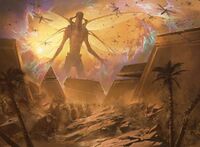
Next, a second twisted god emerged from the vast tomb within the Crypt of the Eternals, this one crowned with the head and wings of a locust, surrounded by swarming clouds of ravenous insects that darkened the twin suns. These locusts devoured the protective magic of the Hekma, tearing down the barrier that kept the desert’s horrors at bay. Waves of choking Shefet sands swept into Naktamun, bringing with them swarms of rampaging mummies as howling dust storms battered the city and its terrified people. At last, the God-Pharaoh himself appeared. While the desperate fled in search of safety, a few clung to hope and pleaded for his aid, only to be met with mocking laughter as he reveled in their ruin. He regarded the Gatewatch with the same contempt, refusing to confront them directly and instead taunting them as chaos spread.
The planeswalkers fought desperately to hold the disaster at bay. Liliana wielded her necromancy to drive back the relentless mummies. Gideon stood firm at Oketra's side as she faced the Scorpion God in her final battle, witnessing her brave but excruciating end. Despite their best efforts, the devastation worsened. Sand poured through broken barriers, toppling monuments while the city’s slain rose again to swell the undead hordes. When Oketra and Kefnet fell, the two surviving gods turned on each other, each hoping to earn the God-Pharaoh's approval through combat. Hazoret fought fiercely, determined not just to defeat Bontu but also to protect the mortals she cherished. Bontu, however, exploited Hazoret's compassion, striking when she was most vulnerable. Dragging Hazoret before the God-Pharaoh, Bontu expected praise and reward.
Instead, Bolas slew Bontu himself, then finally turned his gaze on the Gatewatch. Hazoret seized the moment to break free, carving a path of escape for her remaining faithful. Even as the Scorpion God pursued her, Samut raced after the monstrous killer, refusing to give up the fight.
The Hour of Eternity

Amid the ruin and despair, only a handful were left to see the third terrifying god step through the Gate to the Afterlife. This creature wore the massive head of a scarab beetle, gleaming with a metallic blue sheen. It emerged from the necropolis commanding a legion of embalmed warriors, their bodies coated in the same blue substance — lazotep. These were Bolas's Eternals: the worthy dead of Naktamun, remade into flawless soldiers whose virtues of solidarity, knowledge, strength, ambition, and zeal were preserved within their cartouches.
To the people of Naktamun, the Eternals were a nightmare come true. Their entire lives had been spent striving for a glorious afterlife beside the God-Pharaoh, but now they faced an eternity they could barely comprehend — an unfeeling army of perfect killers stripped of memories yet retaining the martial skills gifted by their cartouches. The Eternals were the final, cruel proof of the lie they had devoted themselves to.
While the Scorpion God hunted Hazoret, Samut and Djeru were finally reunited. Together, they understood that the same five virtues they had trained for were now their last hope to endure this ultimate trial. Rallying as many surviving initiates as they could, they fought back against the Scorpion God and the Eternal horde.
Through fierce battle and sacrifice, the living managed to bring down the Scorpion God by driving it onto an obelisk, proving that even these false gods could fall. In return, Hazoret vowed to stand by the mortals who remained, safeguarding the spirit of Amonkhet so the God-Pharaoh’s deception could never again break its people.
The Hour of Devastion
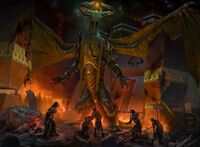
The ancient teachings promising the God-Pharaoh's glorious return spoke of four great hours — four stages that would signal his arrival and fulfill his promises. In the end, these prophecies came true in the most horrific way possible. Amonkhet lay broken and changed forever. But for the Gatewatch, a final confrontation remained. At last, Nicol Bolas stood before them — and one by one, he dismantled them utterly. He faced each planeswalker in turn, twisting their strengths back on them to ensure their defeat was both humiliating and absolute.
Appealing to Jace's hunger for secrets, Bolas offered him a glimpse inside his mind to witness his endless plots. Jace could not resist — and Bolas shattered his mind like glass. Broken and overwhelmed, Jace collapsed, then vanished into the Blind Eternities as his memory fractured.
With Jace gone, the Gatewatch's coordination crumbled. Bolas goaded Liliana to draw fully on the Chain Veil's power, then showed her it was still no match for him. Nissa tried to call on the strength of Amonkhet’s land, only to find Bolas had already poisoned the cycle of life itself, tipping it forever toward death. As her comrades fell, Chandra's rage only grew, driving her straight into Bolas's grasp, where he snuffed out her fire and crushed her nearly lifeless in his claws.
One by one, each of Gideon's friends planeswalked away, beaten and broken. Bolas mocked him for failing to protect them, forcing Gideon to relive his oldest pain: standing alone when everyone else had fallen. At last, Bolas drove a claw through Gideon’s defenses until his invulnerability faltered, forcing him to flee as well. Alone on the ashes of a dying world, Bolas stood triumphant — the God-Pharaoh of ruin.[2] [1]
In-game references
- Represented in:
References
- ↑ a b c d James Wyatt (July 2017) — The Art of Magic: The Gathering - Amonkhet, Viz Media.
- ↑ Ken Troop (July 26, 2017). "Hour of Devastation". magicthegathering.com. Wizards of the Coast.
